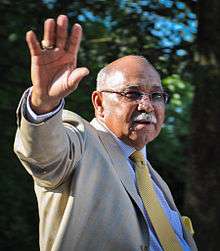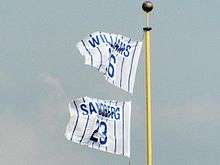Billy Williams (left fielder)
| Billy Williams | |||
|---|---|---|---|
 | |||
| Left fielder | |||
|
Born: June 15, 1938 Whistler, Alabama | |||
| |||
| MLB debut | |||
| August 6, 1959, for the Chicago Cubs | |||
| Last MLB appearance | |||
| October 2, 1976, for the Oakland Athletics | |||
| MLB statistics | |||
| Batting average | .290 | ||
| Hits | 2,711 | ||
| Home runs | 426 | ||
| Runs batted in | 1,475 | ||
| Teams | |||
| Career highlights and awards | |||
| |||
| Member of the National | |||
| Inducted | 1987 | ||
| Vote | 85.71% (sixth ballot) | ||
Billy Leo Williams (born June 15, 1938) is a retired American Major League Baseball (MLB) left fielder who played sixteen seasons for the Chicago Cubs and two seasons for the Oakland Athletics. Williams was inducted into the National Baseball Hall of Fame in 1987.[1] In 1999, he was named a finalist for the Major League Baseball All-Century Team.
Williams was one of the best Cubs players. He was the 1961 NL Rookie of the Year and was a National League (NL) and Cubs All-Star for six seasons. In 1970, he had a .322 batting average with 42 home runs and 129 runs batted in (RBI), led the NL with 205 hits, and was the NL Most Valuable Player runner-up. In 1972, he won the NL batting title hitting .333. Williams hit over 400 home runs in his career including 30 or more for five seasons. He also hit over .300 for five seasons and had over 100 RBI for ten seasons.
Williams was a highly competitive player on Chicago Cubs teams that never reached the post-season. When he finally played in the post-season during the next to final year of his career with the Oakland Athletics, the "A's" did not play in the World Series. In 1999, he was selected as a member of the Cubs All-Century Team.
Early life
Williams was born in Whistler, Alabama. His father Frank was a stevedore who had also played first base for the semipro Whistler Stars.[2] Williams grew up in a segregated neighborhood.[3] He attended Whistler High School.[4] Entering professional baseball in 1956, Williams started his minor league career with the Ponca City Cubs of the Sooner State League. After returning to Ponca City in 1957 and hitting 17 home runs, Williams split 1958 between the Burlington Bees and Pueblo Bruins.[5]
In his autobiography, Williams recalled that had never experienced overt racial discrimination until his 1959 promotion to the Class AA San Antonio Missions in San Antonio, Texas. He was so discouraged that he left the team and went home. Buck O'Neil, the Cubs scout who had originally discovered Williams, was dispatched to Whistler and he persuaded Williams to return to the team.[6] During the 1959 season, he advanced to the Class AAA Fort Worth Cats and even played 18 games for the Cubs.[4][5] In 1960, he hit 26 home runs for the Class AAA Houston Buffs and played in 12 major league games.[4][5]
MLB career
Chicago Cubs
Williams joined a Chicago Cubs team that would feature stars such as Ernie Banks, Ferguson Jenkins, and Ron Santo by the early 1960s. Rogers Hornsby (seven NL batting titles), who by 1960 was serving as a scout and coach in the Cubs organization, predicted Williams would someday win a batting title.
Williams debuted with the Cubs late in the 1959 season, and played in a total of 30 games in both the 1959 and 1960 seasons. In 1961, he played in 146 games and was selected as the NL Rookie of the Year. That year he hit 25 home runs and drove in 86 runs. In 1962, 1964 and 1965, he was named was a NL All-Star.[4] He won the NL Player of the Month Award in May 1964 with a .455 average, 8 HR, and 22 RBI. Williams struggled defensively in the first few years of his career, leading NL outfielders in errors as a rookie. By the mid-1960s, his defense was no longer seen as a serious weakness.[2] He would return to the All-Star Game in 1968, 1972, and 1973.[4]

From 1961 to 1973, Williams annually hit at least twenty home runs and was responsible for eighty-four or more RBIs. His batting swing was smooth and efficient, with quick wrist action that allowed him to hit for both average and power despite his slender frame. Early in his career, this earned him the nickname "Sweet-Swinging Billy Williams", sometimes shortened to "Sweet Williams" or "Sweet Billy" (perhaps suggested by the flowers known as sweet williams). His nickname was later referenced in the subtitle of his autobiography. He was also nicknamed "Sweet-Swinging Billy from Whistler", suggesting his birthplace in Alabama. His home run feats included hitting 20 or more home runs for 11 straight seasons, hammering three homers in one game and five in two consecutive games. Twice in one season, Williams belted four extra-base hits in a game.
In 1970, Williams batted .322 with 42 homers and 129 RBIs and finished second in National League Most Valuable Player voting; surprisingly, despite batting .319 with 26 HR and 80 RBI at the All Star break, he was left off the All Star team. Williams set a National League record for consecutive games played with 1,117 in 1963–70 (eclipsed by Steve Garvey in 1975–83 with 1,207). As his consecutive games streak began to accumulate, he was dubbed "Iron Man" by some writers.[7] He co-authored a 1970 book called Iron Man. In 1972, he was the National League batting champion and named the major league Player of the Year by The Sporting News.[8] He paced the league in batting average with a .333 mark, also posting a .606 slugging percentage while collecting 37 home runs and 122 runs batted in (RBI). He finished second for the second time in the MVP selection, behind Johnny Bench (he would never win the award, or finish above 29th again). He won his second and final NL Player of the Month Award in August (.438, 9 HR, 29 RBI)
Oakland Athletics
Williams was traded to the American League's Oakland Athletics after the 1974 season for second baseman Manny Trillo and two pitchers.[9] He helped lead Oakland get to the 1975 American League West championship as a designated hitter, hitting 23 homers with 81 RBI. In 1976, Williams played in only 120 games and hit only .211.[4] He retired that year. Williams accumulated a lifetime .290 batting average with 426 home runs and 1475 RBI.
Later years
 | |
| Billy Williams's number 26 was retired by the Chicago Cubs in 1987. |
Williams credited a grade school teacher with encouraging him to always try to improve, citing the old saying, "Good, better, best / Never let it rest / Until the good is better / And the better is best."[10]
Williams was elected to the Baseball Hall of Fame in 1987. On August 13, 1987, Williams' uniform number 26 was retired at Wrigley Field. His was the second number to be retired by the Cubs, the first being Ernie Banks' number 14. Following his departure from the Cubs, the number was reassigned to other players from time to time, most notably Larry Biittner, although Williams reclaimed it during several intervals of coaching with the Cubs after his playing days had ended.
In 1999, he was selected to the Cubs All-Century Team and was named as one of the one hundred finalists to the Major League Baseball All-Century Team. During the 2010 season, the Cubs honored Williams with a statue outside of Wrigley Field in Chicago. The statue was unveiled in a pre-game ceremony before their home game on September 7 against the Houston Astros.[11]

In 2011, Williams was appointed as a member of the National Baseball Hall of Fame's 16-member Golden Era Committee (replaced the Veterans Committee) which considers ten Golden Era candidates every three years for the Hall of Fame. The ten candidates from the 1947 to 1972 era are first identified by the Baseball Writers' Association of America (BBWAA) appointed Historical Overview Committee (10-12 BBWAA members) every three years. Former Cubs third baseman Ron Santo was the only Golden Era candidate elected to the Hall of Fame by "The Committee" (includes 8 members of the Hall of Fame) during their winter meetings in December 2011 (and 2014).[12]
See also
- List of Major League Baseball home run records
- List of Major League Baseball career home run leaders
- List of Major League Baseball career hits leaders
- List of Major League Baseball career doubles leaders
- List of Major League Baseball career runs scored leaders
- List of Major League Baseball career runs batted in leaders
- List of Major League Baseball batting champions
- List of Major League Baseball annual runs scored leaders
- Major League Baseball consecutive games played streaks
Notes
- ↑ National Baseball Hall of Fame Retrieved May 5, 2015
- 1 2 Armour, Mark. "Billy Williams". Society for American Baseball Research. Retrieved September 6, 2013.
- ↑ Williams, p. 1.
- 1 2 3 4 5 6 "Billy Williams Statistics". Baseball-Reference.com. Retrieved September 6, 2013.
- 1 2 3 "Billy Williams Minor League Statistics & History". Baseball-Reference.com. Retrieved March 26, 2015.
- ↑ Williams, p. 8-11.
- ↑
- ↑ Cooperstown: Where the Legends Live Forever, by Lowell Reidenbaugh, edited by Joe Hoppel, and compiled by the Editors of The Sporting News. New York, Gramercy Books, 1999.
- ↑ A's get Billy Williams in trade with Chicago
- ↑ Williams, p. 210.
- ↑ http://archive.chicagobreakingsports.com/2010/09/billy-williams-statue-unveiled-during-ceremonies.html[]
- ↑ National Baseball Hall of Fame and Museum, December 5, 2011: "Ron Santo Elected to the National Baseball Hall of Fame by Golden Era Committee"
References
- Williams, Billy; Mitchell, Fred (2008). Billy Williams: My Sweet-swinging Lifetime with the Cubs. Triumph Books. ISBN 978-1-60078-050-9. Retrieved March 26, 2015.
External links
- Billy Williams at the Baseball Hall of Fame
- Career statistics and player information from Baseball-Reference, or Fangraphs, or The Baseball Cube, or Baseball-Reference (Minors)
- BaseballLibrary.com
- Baseball Almanac
- "Its all about R-e-s-p-e-c-t for 'Sweet Swingin' Billy Williams
- The Williams-Santo Cubs 1961-1965 @ The Hardball Times
| Preceded by Willie Mays César Cedeño |
Major League Player of the Month May 1964 July 1972 |
Succeeded by Jim Bunning Ken Henderson |